The following text by Gianluca Poldi is taken from the essay of the same name in the catalog of the exhibition Angelo Morbelli. Light and Color (at Bottegantica in Milan, until March 16, 2019), dedicated to the great Divisionist painter Angelo Morbelli (Alessandria, 1853 - Milan, 1919) on the centenary of his death.
It is impossible to observe a pointillist work without contemplating its technique, peculiar, not infrequently superfine, striking in its executive meticulousness accompanied by a maniacal search for the effect of light and thus of color, and finally, in Morbelli’s case in a preclaric way, accompanied by an ethical tension evident in recounting social themes. The division of the brushstroke into minute strands and strokes of unmixed colors on the palette comes for Morbelli as a result of the 1889 Parisian trip and subsequent readings and reflections, taking a still embryonic form in one of his first divided works, Alba (1890-1891), now at the MNAC in Barcelona, exhibited at Brera in 1891 along with Un consiglio del nonno - Parlatorio del luogo Pio Trivulzio (1891). Then it would be perfected in the span of a few years until it reached that acuity of pictorial hatching with skillful color combinations that we recognize in mature works such as Per ottanta centesimi! (1895) from the Borgogna Museum in Vercelli and others on the theme of mondine, or in theSelf-Portrait(The Artist and the Model or Self-Portrait in the Mirror) of 1901.
In the latter, a true work-manifesto, the painterly division of the brushstroke is concentrated where it is needed, in the figures and parts of the environment, while symbolically the light is broken down into the colors of the iris (as from a prism) on the edge of the mirror in which the painter himself and the model’s shoulder are reflected. A painting from the Poem of Old Age cycle, namely The Empty Chair, which was exhibited in Venice in 1903, also appears in the mirror, i.e., as a counterpart: as noted, it is an undivided work, probably testifying that the painting was unfinished, also missing the red color of the women’s shawls. The long gestation of the latter passes through the very detailed preparatory drawing in black and white pastel dated 1902, which conforms to the redaction brought to Venice, and a sketch such as Vecchina that is particularly illuminating of Morbelli’s technical progress and timely testimony to his conception of divided painting: the construction of the division from a rather detailed graphic and then pictorial sub-model with lights and shadows, then literally covered with the wreath of divided brushstrokes with various cross orientations, made with “comb” brushes with three to six fine points arranged in a line, laying down strokes even less than a millimeter wide. The same brushes he would use for years, also made by himself. The small oil painting, only 12.5 x 13 cm, is made on an unusual medium for Morbelli, but one particularly beloved instead by the Macchiaioli, the lid of a cigar box, and shows the study of the black bonnet and red shawl in a manner quite similar to what we see in the final painting, while in the skirts the method is not yet fine-tuned: over a base of undivided white paint and, in the shadows, gray, he lays touches of blue, yellow, orange and light green without yet achieving that soft effective amalgamation of the final version [...].
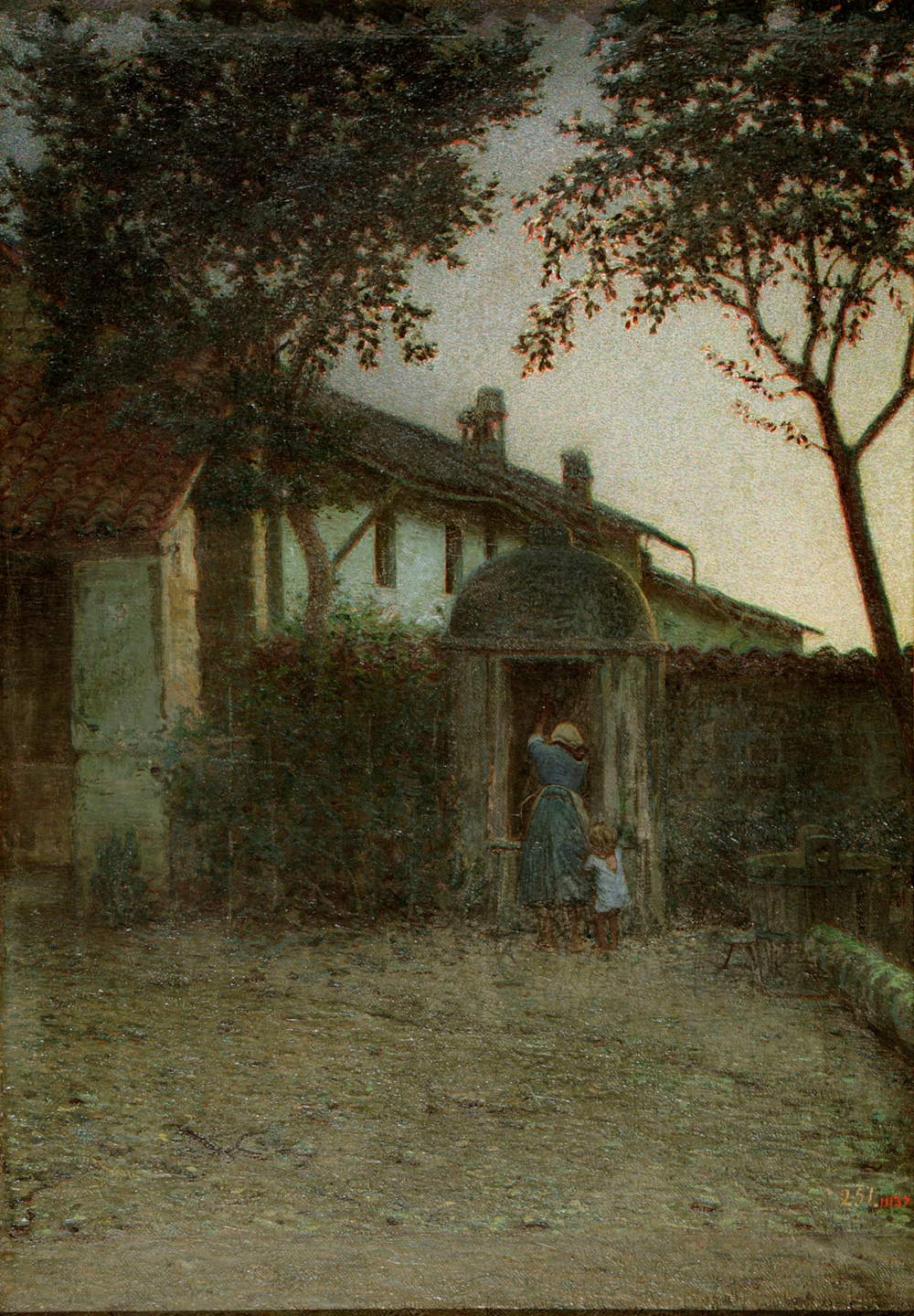 |
| Angelo Morbelli, Sunrise (1891; oil on canvas, 79 x 55 cm; Barcelona, MNAC - Museu Nacional d’Art de Catalunya) |
 |
| Angelo Morbelli, Un consiglio del nonno - Parlatorio del luogo pio Trivulzio (1891; oil on canvas, 60 x 45 cm; Alessandria, Fondazione Cassa di Risparmio di Alessandria) |
 |
| Angelo Morbelli, Self-Portrait in the Mirror or The Artist and the Model (1901; oil on canvas, 123 x 91 cm; Private collection) |
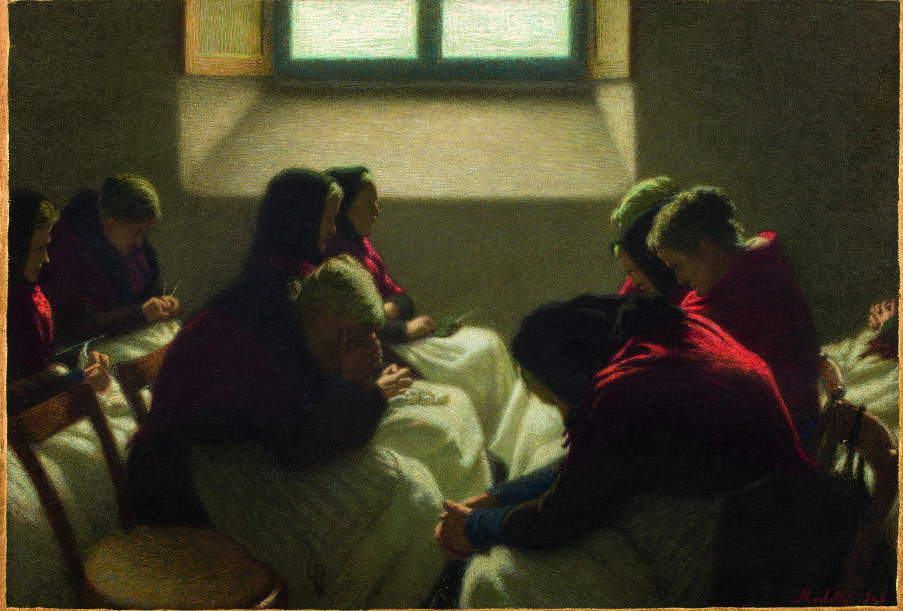 |
| Angelo Morbelli, The Empty Chair (1903; oil on canvas, 61 x 87.5 cm; Private collection) |
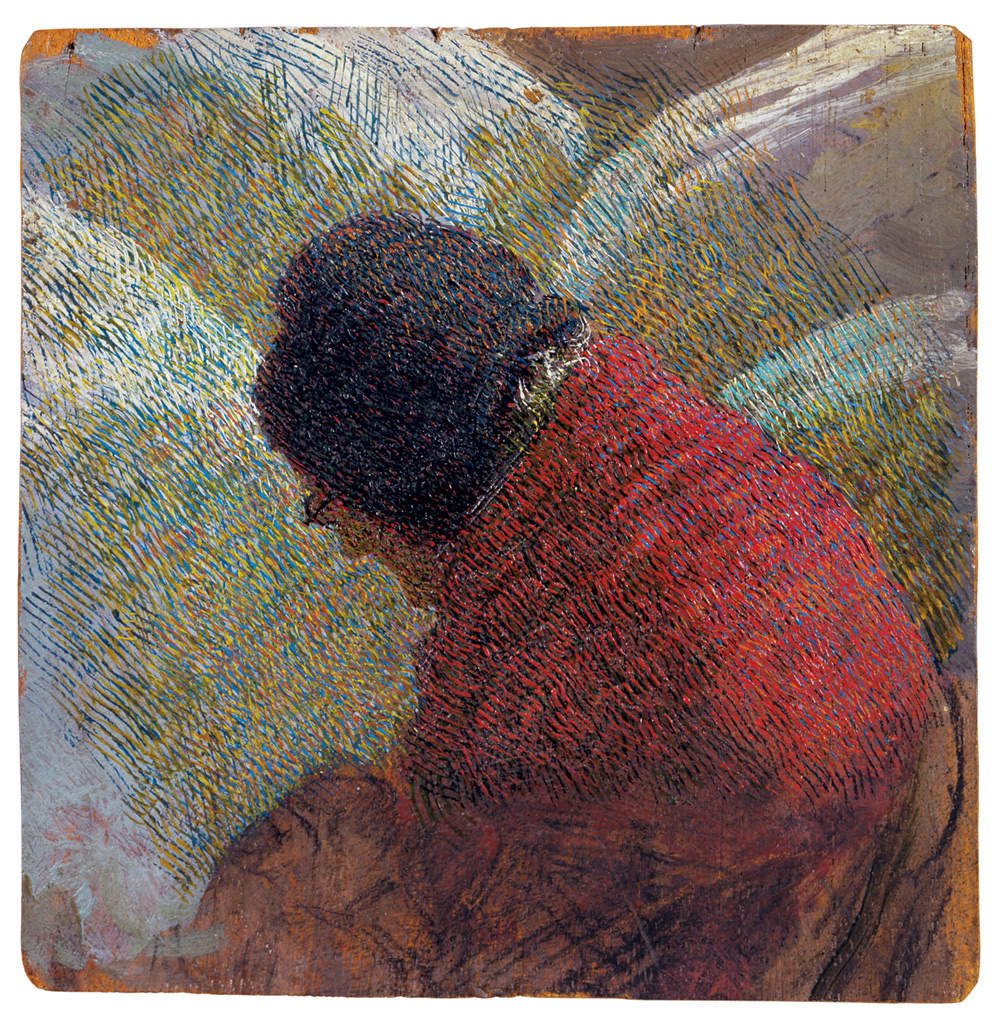 |
| Angelo Morbelli, Vecchina (1901-1902; oil on panel; Private collection) |
I have wondered why it was not enough for Morbelli to enlarge a small drawing directly-through quadrature-to the large format of the canvas, that is, directly onto the canvas, and I believe the answer lies in the function of the large-format drawing: these are always, in the cases of the surviving drawings, carefully worked sheets of black hatching (black pastel, Conté pencil, on beige paper) and white pastel elevations. They are drawings that aim to reproduce chiaroscuro transitions, that is, the play of light and shadow, in a precise way, or rather constitute the pre-color study of shadow/light relationships, similarly to the way some ancient painters did in their sheets, albeit in a small format, working “chisel-like” at the stroke, now with black or red pencil, now with pen. Some sheets by Michelangelo, and earlier by Mantegna, Giovanni Bellini, and Carpaccio, to name a few, are thus worked with curated hatching, especially on the Florentine side for the study of the incidence of light on anatomies and on the Venetian side for the examination of light on the whole of figures and drapery. The graphic structure of dense parallel and sometimes crisscrossing strokes conducted with a brush under the skin of the painting by Giovanni Bellini for decades, between the 1560s and the early 1590s, so as to obtain a true grisaille before finally covering them with color closely recalls the work Morbelli more than four centuries later did on paper, together a study of light and volume, a certain support to the meticulous work of the brush with color. After all, on closer inspection, a painting as unnatural and difficult during the realization phase as the pointillist one, which starts from filaments of one color to move on to a successive layering of another color, again by more or less dense threads, then yet another, until eventually touching up with the first color and completing up to the desired effect that only step by step reveals itself, not only requires patience and experience, the ability to pre-vision the final outcome, but further needs a solid support in adequate scale to verify in black and white the modulation of the light vibrato. And it also needs to study some solutions at the level of pictorial evidence, even on smaller media [...].
The theme of backlighting affects several of Morbelli’s works, among them Incensum Domino! of 1892-1893, where the source of light is the windows, with the panes of glass pierced by light, that is, painted with a white spread in horizontal filaments, with passages of yellow, blue and pink, barely perceptible in the white. Then the light bangs on the jambs, which respond with light blue borders streaked with minute touches of yellow, while the walls in the dark are veined with dark blue diagonally, following the course of the canvas, then dashed with orange. Also initiated with this work is the study of partially colored shadows, the result of the participation of chromatically distinct tones, and attention to the phenomenon of chromatic aberration, which results in images that present colored halos at the edges of objects and figures. The floor houses the signature arranged as the curve of the decorative motif, a rare fact, and is painted by coating the medium-light brown background of ochre and earths with a speckled pink impasto; the pink is two tones, the lighter one in the decoration, which in turn is worked with light violet and yellow marks, thus in ways that are not strictly divided. In fact, Morbelli does not use the hatching of division in an always orthodox and uncritical way, but rather contemplates other technical-expressive possibilities. The clothes, apparently black, are instead a sum of colors among which blue, brown and yellow are best noted, some bright red or lacquer darkened today, where bright yellow and orange touches help to make the fabrics and thus the figures at prayer more vibrant. Also on diagonal-weave canvas is the study that we can link to this painting, theChurch Interior in the GAM in Turin a whose blue window sill and glints of glare from the draperies of the praying figures the painter noted, which he would later with variations use in the large canvas [...]. The herringbone support is Morbelli’s favorite and frequently employed for large works, allowing a good hold of color the possibility of exploiting the texture of the canvas for particular effects, both for divided and unsplit works.
 |
| Angelo Morbelli, Incensum Domino! (1892; oil on canvas, 80 x 120 cm; Tortona, Pinacoteca “Il Divisionismo”) |
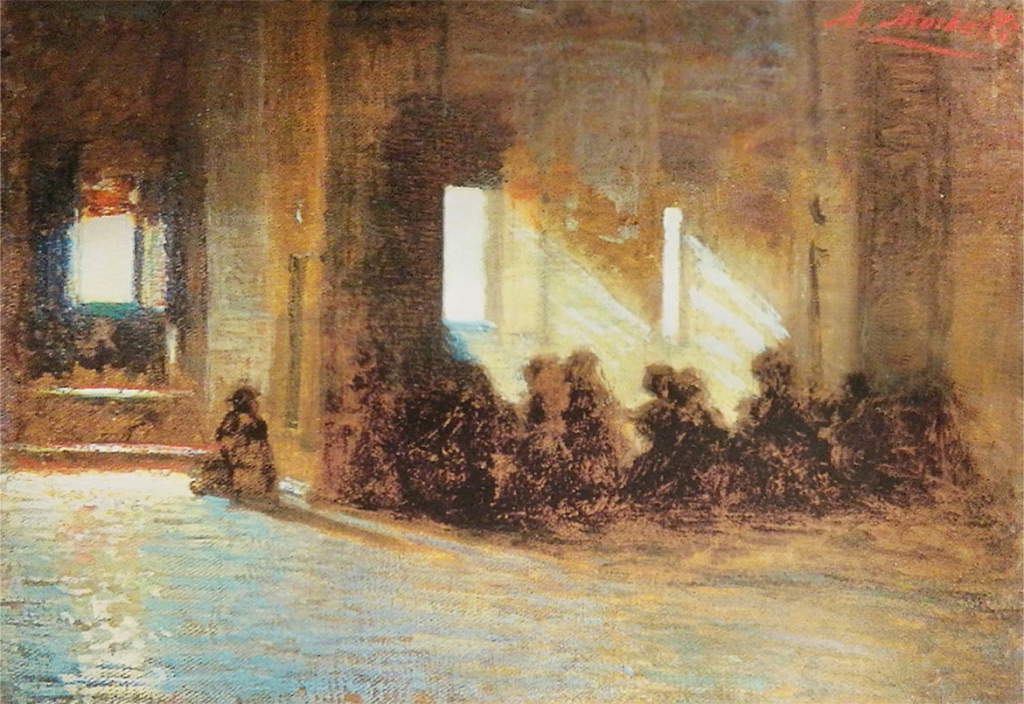 |
| Angelo Morbelli, Interno di chiesa (1893; oil on canvas, 27.5 x 37.8 cm; Turin, GAM - Galleria d’Arte Moderna) |
This is also true of paintings that predate the Divisionist choice: in 1884 in Asphyxia for example, the diagonal pattern of the fabric is used to give greater chromatic depth to the tablecloth, which even has a black chromatic background that can be glimpsed precisely in the hollows of the fabric that the white deliberately does not cover in order to exploit them in the shadows, in fact only partly achieved with gray brushstrokes. The representation of light (and in this case of white), of its multiple effects of reflection, transparency, chiaroscuro, absorption, is a problem that Morbelli poses quite early on, in my opinion, if one looks at the solutions that he gradually goes looking for and finding before and after the Divisionist turn. Again in Asphyxia, which shows the exceptional skill of the 30-year-old painter, in the canvas kept at the GAM in Turin capable of staging a virtuosic still life in an interior in which light has a fundamental unraveling effect, clumping on certain objects such as the porcelain on the table with textural touches executed with a brush and sometimes with a spatula, or rather a knife. The same material, but a deep yellow color, is exploited to render the light penetrating the shutters, with an unusual and highly effective effect. In the same year he painted one of the two versions of Venduta (Pall Mall Gazette), simplified from the one preserved at the GAM in Milan, where the sheet is instead rendered in the traditional way with impasto and various tones of white soiled with grayish-brown, and alternating browns and dirty whites render the (symbolic) stains on the girl’s skin. Regarding the rendering of whites, even in the Divisionist period Morbelli does not always work with his hatching technique, as we see, for example, in the Riposo alla colma of 1898, with the woman’s dress not really divided but only crossed by light blue and pink touches. So too, he experiments with the use of spots instead of lines in part of the little wall and in the flowering bushes, as well as in the sky-which may remind one of Longoni in its attempt to blend colors-while thin strokes are applied to the landscape in a disjointed, and nonetheless, interesting, jerky manner, seeking other solutions from the usual ones.
Twenty years later, the stretched linen of Distendendo panni al sole (1916) presents both ways, hinting at the occasional division that in some cloth is only in white or yellow on white. Here it is that in Morbelli the divided painting can also be monochrome or almost monochrome, as in some cycles of Paese montano, a work that can be placed in the second half of the first decade of the century, with the crossed white-blue hatching resting on brushstrokes of the same color in which the painter lets the grooves of the brush read, interwoven with thin light yellow threads [...]. The luminous vibration obtained after 1890 from that precious work as of a burin, graphic work within color, mindful of the drawing of previous great masters but also of great engravers, in search of the best texture (texture) and yet at the same time of the right accord of colors (not necessarily strictly complementary), is handled by Morbelli, as we have seen for small examples, with an underlying sense of freedom, aware that technique is a tool and not an end, and should not trap the artist who has a duty to remain mobile and adherent on the one hand to experience and idea, and on the other to context and research. So much so that in some works of the last years he limits the use of divided ductus to a few areas, depending on the particular luminous effects sought. In very rare cases Morbelli experiments with drafts in which the color even seems to be pulverized, as in the sky of the Risaiuole of 1897 (private collection), obtained by means of drafts, made by disuniform spots, such that they mix optically in peculiar effects, barely crossed by rare hatching: not divided therefore or not in the canonical sense of the term.
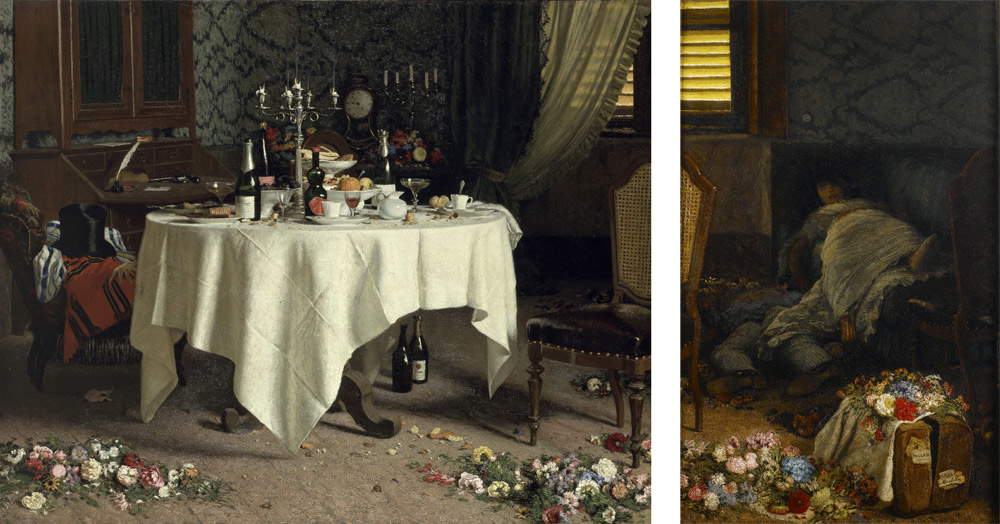 |
| Angelo Morbelli, Asfissia! (1884; Left part: oil on canvas, 159 x 199.5 cm; Turin, GAM, Galleria Civica dArte Moderna e Contemporanea, Guido and Ettore De Fornaris Foundation. Right part: oil on canvas, 160 x 98 cm; Private collection) |
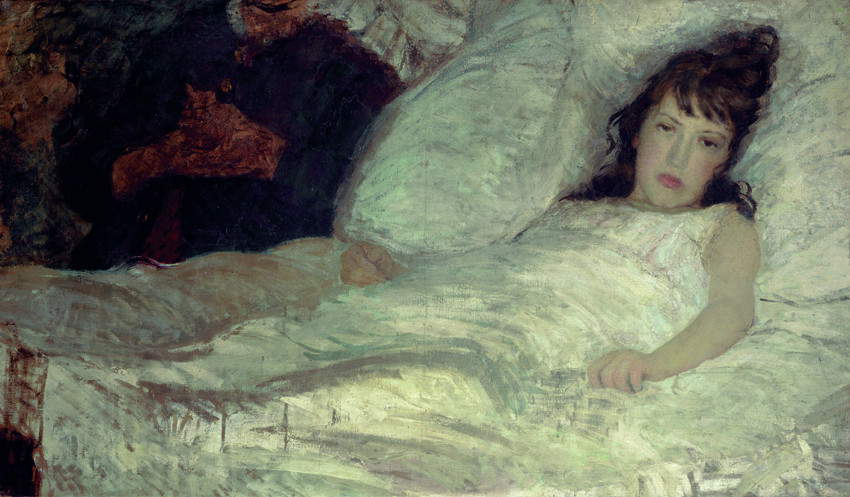 |
| Angelo Morbelli, Sold (1884; tempera on canvas, 70 x 120 cm; Milan, GAM - Galleria d’Arte Moderna) |
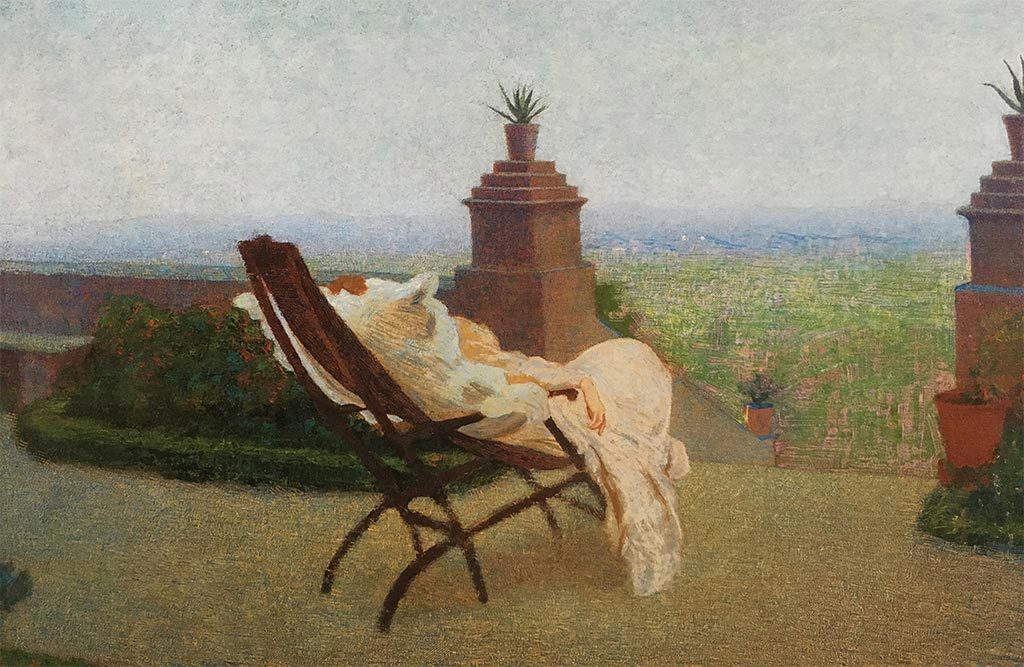 |
| Angelo Morbelli, Resting at the Fill (1894-1898; oil on canvas, 75 x 110 cm; Private collection) |
 |
| Angelo Morbelli, Distendendo i panni al sole (1916; oil on canvas, 43.5 x 62 cm; Private collection) |
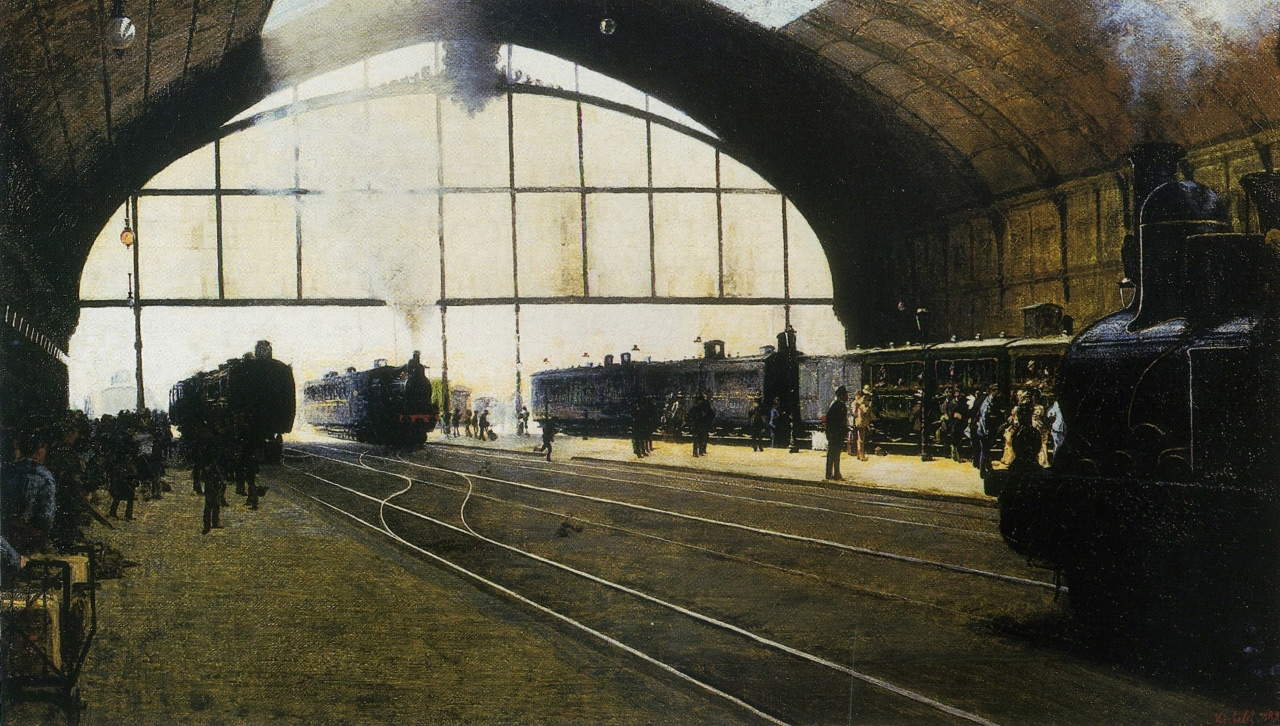 |
| Angelo Morbelli, The Central Station in Milan (1887; oil on canvas, 57.5 x 100 cm; Milan, GAM - Galleria d’Arte Moderna) |
 |
| Angelo Morbelli, The Central Station of Milan, detail |
But even before the division, that is, the decomposition of light, Morbelli operates a painting of refined quality, attentive to subtle chromatic variations, with a somewhat pre-divided attitude and technical attentions close toImpressionism. First of all, a peculiar attention is paid, in many paintings before 1890, to the materiality of the chromatic background, over the white preparation: the painter likes to make the background mixture locally coarse and rough, not caring about the presence of lumps of color and brush hairs, aiming to obtain particular effects of texture and reflection of light. [...] Thick and rough chromatic bases allow him to superimpose brushstrokes of non-fluid color that do not cover them completely, leaving parts of the underlying layers visible: a similar effect is exploited for the train carriages of the Central Station, blue-white on black, both in the version of the Ferrovie dello Stato and that of the GAM in Milan. [...] The working by touches that end up partly blending directly on the canvas, “wet on wet,” and partly leaving the underlying color visible, is well seen in the colorful mass of travelers by the tracks, as well as in an almost coeval work, the Spigolatrici, of 1889, a prelude to the later Mondine and many other outdoor or indoor landscapes in which light will build space in color and in the qualities of the brush’s touch, wire to wire. In absolute fidelity to the luminous vibrato, where Morbelli’s fascination with the luminous writing of photography, which he also extensively employs, can flank but not replace the truth of color and meaning, of personal translation of reality, of sensibility and ideality, the refined cultural game, in short, that is painting.
I dedicate this Morbellian reading to Padi, life companion
Selected bibliography
Warning: the translation into English of the original Italian article was created using automatic tools. We undertake to review all articles, but we do not guarantee the total absence of inaccuracies in the translation due to the program. You can find the original by clicking on the ITA button. If you find any mistake,please contact us.